What is Note Bending?
Note bending is a technique used to change the pitch of a note and so reach notes that are not on a diatonic harmonica, For example, if you take the fourth hole on a key C harmonica, the blow note is a C and the draw note is a D. It is possible to play a C# by bending the 4 draw down by one half tone. This is accomplished by using a combination of your tongue, throat and lungs to vary the pressure of the air across the reed. Bending notes can be one of the more difficult techniques to master (it took me quite a while). Note bending lends that bluesy sound for which harmonica is known, and can be used in combination with other effects such as wah-wah to add more style and diversity to your playing. The 4 Draw was the first note that I learned to bend but this isn’t true for everybody. If you have a lot of difficulty, practice your bends on other holes (either; 1 Draw, 2 Draw or 3 Draw).
Bending Hole 4, from D down to C#
We are going to jump straight in by discussing how to physically bend a note, I will explain the theory later. I’m going to start this lesson by demonstrating the 4 draw bend on a C harmonica. This is bending from note D to C#. Listen to it first.
Now that you know what it sounds like we are going to describe how it’s done. Different folk have different ways of describing how to bend a note. This is a description of what I feel is happening. Look at the tongue movement in the picture below. While I am inhaling on the fourth hole, I dip the center of my tongue down leaving a larger space inside my mouth. The action of dipping my tongue down brings the note from D down to C#.
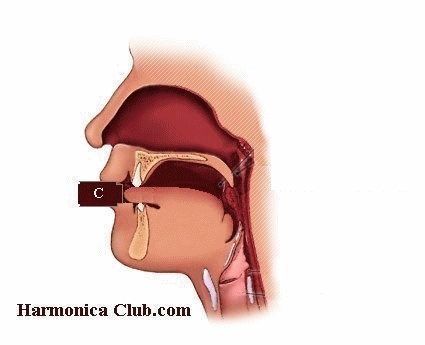
This is difficult to do because you will be training your tongue to do something unusual that it has never had to do before. But when you get the hang of it, it will be as easy as riding a bicycle. There are a few tricks that may help.
Can you whistle backwards? (make a whistle while inhaling). Whistle backwards and change the pitch of the whistle while inhaling. You will notice that you are moving your tongue back in your mouth, and so increasing the volume of the cavity or space within your mouth. This is a similar effect, but you will be doing this while leaving your tongue on the harmonica. You need to be able to leave your tongue on the harmonica, so that you can bend notes while tongue blocking (the style of playing which was described on the first lessons page).
When I was first trying to bend notes, it didn’t come to me straight away. One of the things I did was to put some scotch tape (sellotape or sticky tape) on the front of the harmonica, so as to block all the holes except the one I was practicing on. This meant that I could achieve a bend using the whistle backwards method, and not be concerned about tongue blocking. If you are having difficulty bending a note while tongue blocking, this exercise will give you the sound and feel of playing a bent note. Although on the other hand, you really don’t want to be covering your harmonicas in scotch tape if you can avoid it.
Bending Hole 3, from B down to Bb, A and Ab
The three-draw note on the harmonica can be bent down in three stages of a half tone each. Listen to the next recording to hear how it sounds.
The picture below shows the varying position of tongue during these notes.
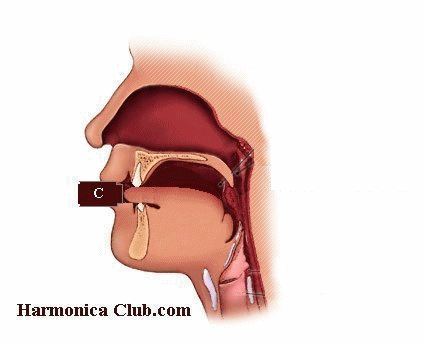
The first note B is a straight note and can be played simply by inhaling on the third hole of your harmonica. You can then drop the pitch of this note down to Bb, A, and Ab, by dipping the center of your tongue down in three stages. You may find it difficult to tell if you are landing exactly on each half tone, so another good exercise is to finish on the 3 blow note. Finishing on the 3 blow note will mean that you are playing 5 notes of the chromatic scale on one hole of your harmonica, B, Bb, A, Ab, and G. This will make it easier for you to hear if you are spacing them apart properly (one half tone each).
Bending Hole 2, from G down to F#, and F
The two-draw note on the harmonica can be bent down in two stages of a half tone each. Listen to the next recording to hear how the bend sounds.
The picture below shows the varying position of the tongue during these notes.
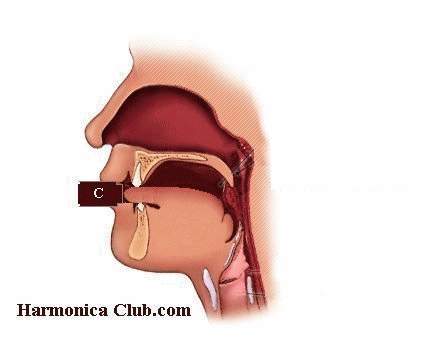
The first note G is a straight note and can be played simply by inhaling on the second hole of your harmonica. You can then drop the pitch of this note down to F# and F, by dipping the center of your tongue down in two stages.
As you start to get the feel for these different bends you will notice that each hole behaves and feels different form the last. The larger reeds in the lower pitched holes allow a greater flow of air through the harmonica and into your lungs. This means that you will be inhaling a greater volume of air to achieve the pressure difference required to reach the bend. This will be particularly noticeable on the first hole.
Bending Holes 1, 5 and 6
The draw note on the first hole of your C harmonica can be bent down by a half tone, from D down to C#. These are the same notes as you played while bending the fourth hole, but they are an octave lower. You will notice that you are inhaling a lot more air while playing this bend. You won’t have to worry about tongue blocking on the first hole, so you can draw your tongue back into your mouth if this makes it easier. The bend should sound like this.
You will be able to bend hole 5 down from E, but this is less than a half of a tone (even though it sounds like F). This bend can be used for effect but should not be used to play the note F. Some people also claim that bending the 5 draw damages the reed in that hole, but I don’t see why it should.
The sixth draw note on your harmonica can be bent by a half tone from A down to Ab, and it should sound like this.
This picture is here to illustrate all possible bends on a harmonica, We have just covered draw bends on holes 1 to 6. When learning how to play harmonica, beginners generally find the blow bends on holes 8 to 10 more difficult. So for the next exercise we will talk about some techniques that can be used in combination with bends.
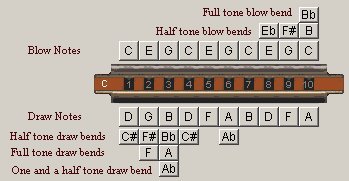
Wah-wah
The wah-wah effect is achieved by opening and closing your hand at the back of the harmonica. When done in combination with note bending the effect can be enhanced. The first recording is simply a 4 draw without any bending (the note D).
Now! This time, start on the 4 draw bend C#, and release it to the straight 4 draw (going from C# to D). Do this repeatedly so that it sounds like wah-wah. Then add the wah-wah hand-effect.
Train Sounds
A train whistle effect can be achieved if you bend two holes together. Inhale on both 4 and 5 and then bend both notes together.
Blow Bending
Blow bending notes “feels” the exact same as draw bending, yet you will find it a little harder to master. There is no point practicing this technique if you haven’t mastered the previous exercises. So, practice draw bending until you feel very comfortable with it.
Blow Bending Hole 8, from E down to Eb.
Hole 8 on your C harmonica can be bent down by a half tone from E to Eb.
The picture depicts what I feel that I am doing. I lift my tongue at the back and blow with “ever so slightly” more force. If you are having difficulty it will be easier if you start on a lower key harmonica, like G or A. You can then work your way up through the different key harmonicas.
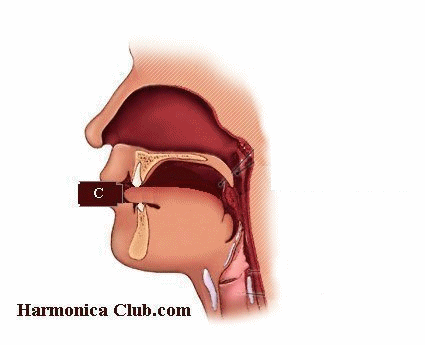
Blow Bending Holes 9 and 10.
Hole 9 is a similar experience but a little more difficult. It will bend from G down to F# (half tone).
The 10 hole blow bend on a C harmonica, will bend from C down to Bb (full tone). This is very difficult to do on a C harmonica and I find it hard to hold the note for any length of time. You will find it easier if you start with a G harmonica and work your way up to your C harmonica.